19.09.2005
M.Notkin. Beauty will save the world
The games considered here were played by 12 chess players from 11 countries in 6 different places on our glorious planet, which is teared apart by political, national, ecological and interpersonal contradictions. Beauty will save the world. Amen! The review begins.
ZhaoXue – T.Petrosian
China 2005
Experienced chess fans or those who study classic heritage carefully remember how Tigran Petrosian had great difficulties finding the keys to the Tarrasch defense used by Boris Spassky in the match of 1969 year. And now, many years later in a faraway China, the namesake of the 9th world champion stumps the two-time Olympic champion as Black. For someone it's a trivial coincidence, and let say Borges could write a lovely story with refined symbolism on that.
1.d4 d5 2.c4 e6 3.¤c3 c5 4.cxd5 exd5 5.¤f3 ¤c6 6.g3 ¤f6 7.Ґg2 Ґe7 8.0-0 0-0 9.Ґg5 cxd4 10.¤xd4 h6 11.Ґe3 ¦e8 12.¦c1 Ґf8 13.a3. There was time when I couldn't understand the aim of this preventive move in Karpov's game. Then several times my opponents got the counterplay, coming with bishop on b4 in proper time, and the question was decided.
13...Ґg4 14.h3 Ґe6 15.¤xc6 bxc6 16.Ґd4. On 16.¤a4 Anand suggests 16...Јc8 17.ўh2 Јa6.
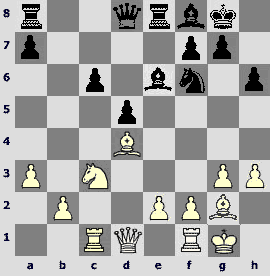
16...¤h7. It's time for a small theoretical digression. Illescas against Karpov (Leon 1993) used this maneuver, with the bishop retreat included – 16...Ґd7 17.Јd3 ¤h7. Anatoly Evgenjevich also withdrew his bishop – 18.Ґe3 (18.e4 c5 didn't suit him for evident reasons), and here instead of logical 18...¤g5 with the idea of 19.Ґxg5 hxg5 20.e4 dxe4 21.¤xe4 Ґxh3! Miguel went on shifting from one foot to another – 18...Ґd6 19.¦fd1 Ґe6 20.b4 ¤f8 21.¤a4. Then the demonstration of Karpov's technique followed, and in about 15 moves everything was finished. Alexei Lugovoy in the game with Johannessen (Gausdal 2004) was more consistent and equalized by 13...Ґe6 14.¤xc6 bxc6 15.Ґd4 ¤h7 16.¤a4 Ґd7 17.Ґc5 ¤g5 (empty h3 square is also attractive for Black) 18.Ґxf8 ўxf8 19.e3 ўg8 20.¤c5 Ґh3.
In the position on the diagram 16...c5 doesn't work, although we can hardly claim that White has clear advantage after 17.Ґxf6 Јxf6 18.¤xd5 (in case of 18.Ґxd5 ¦ad8 Black wins back the h3 pawn, because White cannot make a move 19.ўh2? Ґxd5 20.¤xd5 Јe5) 18...Јxb2. 19.¤c7 doesn't win the exchange, because Black removes the rook attacking the queen. Indeed there is a danger of getting broken pawns in case of ¤xe6 fxe6, but White still has to make an effort for that. And finally let's consider one more aspect: for Black it's all-out defense, 16...¤h7 is more substantial.
17.e4. Of course, as the knight went away from the centre, control over the e4 square was weakened, and nevertheless White doesn't have sufficient reasons for this advance. Grandees treated this position in the following way:: 17.¤a4 Јd7 18.h4 Ґf5 19.¦e1 Ґe4 20.Ґc5 Ґxg2 21.ўxg2 ¦e4 (it only seems that Black put himself in the fork, but as a matter of fact on 22.Ґxf8 there is 22...¦xh4! with perpetual check) 22.e3 Јf5 23.Ґxf8 ¤xf8 24.¤c5 (risky 24.¦xc6 Јd7 25.Јc2 ¤g6) 24...¦e5 25.¤d3 ¦e6 26.¤f4 ¦f6 27.Јd3 Јg4 28.f3 Јd7 29.e4 dxe4, draw (Gelfand-Grischuk, Biel 2001).
17...dxe4 18.¤xe4 Ґd5. It's likely that Zhao Xue hoped on 18...Ґxh3 19.Ґxh3 ¦xe4 20.Ґe3. Bishops attack the queenside and quickly win everything back. However, events took different turn and the h3-pawn was captured by another animal.
19.Јd3. A respectable chess player would take equality after 19.¤c3 Ґxg2 20.ўxg2 Јd7. Although it's hard to see a marvelous combination of Black but the instinct would tell that the central piece group hangs in mid-air.
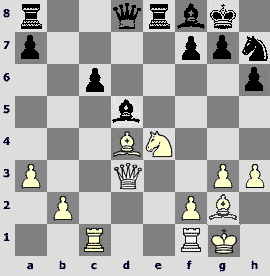
19...¦xe4!! 20.Ґxe4 ¤g5 21.Ґxd5. One has to write an invitation for Black to the long diagonal. Varitions 21.Ґg2 Ґxg2 22.ўxg2 c5 and 21.f3 Ґxe4 22.fxe4 c5 show that the cement used for 19.Јd3 was of a poor quality.
21...Јxd5 22.¦c3. If 22.f4, then 22...¤e6. In case of 22.¦fd1 Black could transpose the game to the position in the text by 22...¦d8, because White hardly has anything better than 23.¦c3, but 22...¤f3+ 23.ўf1 ¦d8 24.Ґe3 Јxd3+ 25.¦xd3 ¦xd3 26.ўe2 ¤e5 27.f4 ¦b3 28.fxe5 ¦xb2+ 29.ўd3 Ґxa3 30.¦xc6 a5 with extra pawn in the endgame can also be considered.
22...¦d8 23.¦d1 (White tries to keep the centre with what is left of his strength, but here comes the break on the wing) 23...¤xh3+ 24.ўf1. On 24.ўh2 Black has an elegant blow 24...¤xf2 25.Ґxf2 Јh5+ 26.ўg2 ¦xd3 27.¦dxd3, getting material advantage.
24...Јh1+ 25.ўe2 Јg2!? Petrosian maintains the tension and is rewarded with the mistake of the opponent. After 25...¤g1+ 26.¦xg1 (26.ўd2? c5) 26...Јxg1 27.¦xc6 Јh1 Black has positional advantage because of the careless position of white king.
26.Јe3?! As it turns out after Black's reply the queen on this square just disturbs its own pieces. The right choice would have been to put the f2-pawn at the mercy of the opponent and to move the king on the queenside – 26.Јc4 ¦e8+ 27.ўd2.
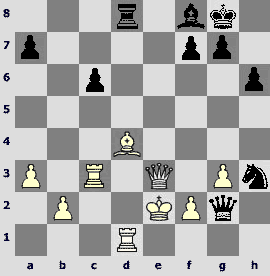
26...¦d6! (with evident and rather unpleasant threat of ¦e6) 27.¦c5. In case of 27.ўd2 ¤xf2 or 27.Јc1 ¦e6+ the king will be executed. In case of 27.Јf3 ¤g1+ 28.¦xg1 Јxg1 Black, in contrast to the variation from the 25th move annotation, keeps the c6-pawn.
27...¤g1+ 28.ўd3. In the official text of the game king moves to d2. But it's hard to believe that the chess player who found out all the idea with 19...¦xe4, would have passed by the trivial 28...¦xd4+ in this case. 28.ўd3 version looks more likely. And comparatively better was 28.¦xg1 Јxg1, where the lousiness of the White's position is somewhere in the middle between what could have happened on 25th and 27th moves. The C6-pawn is on board, but White is better coordinated.
28...¤f3 29.ўc3 ¦e6! 30.Јd3 ¤xd4 31.Јxd4 ¦d6! The rook moved right and left and provided material advantage of Black. The rest is clear.
32.Јxd6 Ґxd6 33.¦xd6 Јxf2 34.¦dxc6 Јxg3+ 35.ўb4 Јb8+ 36.¦b5 Јd8 37.a4 g6 38.¦b7 Јd4+ 39.ўa3 h5 40.¦c8+ ўg7 41.¦cc7 Јd6+ 42.b4 Јg3+ 43.ўb2 Јf2+ 44.ўc3 h4. White resigned. Let's move to the West from great and mysterious China. But I ask you not to catch me on the geographical inconsequence: I will gallop through Europe without any logic. Or there would be smart guys ready to ask about latitude and longitude.
A.Rotstein-F.De la Paz
Barbera del Valles 2005
1.c4 ¤f6 2.¤f3 g6 3.g3 Ґg7 4.Ґg2 0-0 5.0-0 d6 6.¤c3 ¤c6 7.¦b1 e5 8.d3 ¤h5 9.b4 f5 10.b5. Let me determine coordinates once more: the Ukrainian-born German citizen as White and the envoy of Cuba as Black (all the sportsmen from countries with such social order are certainly envoys) played the English opening. As you see, both act purposefully, but the question is whose game is the first to reach a deadlock. Looking through theory I came across a game that I will fully quote here.
10.Јb3 ўh8 11.c5 h6 12.cxd6 cxd6 13.b5 ¤e7 14.¤d2 ¤f6 15.Ґa3 ¤e8 16.¦bc1 ¦b8 17.Јb4 ¦f6 18.¤c4 ¦e6 19.¤e3 Ґd7 20.¤ed5 ¤xd5 21.¤xd5 g5 22.¦c2 h5 23.¦fc1 h4 24.b6 a6 25.¤c7 ¦h6 26.Јc4 hxg3 27.hxg3 f4 28.Јf7 fxg3 29.fxg3 e4.

30.Ґb2 ¦h7 31.Јf8#. Mate. White won. It happened in Philadelphia in the year 1987. 17-year-old Anand was Black, his rating was already 2500. His lucky opponent J.Randolf had no numbers to cite. In the Megabase we can find two more of his games, dated by 1984, and that's all! I'm curious to know what the life of this outstanding person was. I can only suggest the hypothesis I had in other situation…
In his reflections about the reasons of the Goteborg failure Ilya Odessky recollects the match of the chess Olympiad 1980, in which the Soviet team with its best players defeated with great difficulty the Venezuela team. When I were in Venezuela, I was told a lot about this event of historical importance and I naturally asked who played in that team and where they are now, those heroes. It turned out that they are all still living but left chess on account of different reasons. Everyone except for one player, Julio Hostos, whom I had a chance to meet. 20 years after he's still playing for the national team. And I thought it was natural, because he was the only looser. Those who ended in a draw apparently decided it was their limit in chess.
So it was a degression with extensive lyrical content. It's time to return to the game.
10...¤e7 11.¤d5. There aren't many examples of recognized authorities playing this position, but the situation is quite familiar. Belyavsky against Razuvaev (Odessa 1974) didn't hurry with a knight move – 11.Јb3 ўh8 12.a4 etc.
11...¤xd5. Evidently Black hastened to open the c-file to the opponent. 11...f4 or 11...h6 looks normal.
12.cxd5 f4.

13.¦b4! I can't say who was the first to make this maneuver in a structure of this kind, but Rotstein cannot patent it, because the game Bouton-Kahn (Budapest 1990) developed13.¤d2 ¤f6 14.¦b4 g5 15.Јc2 h5 16.¦c4 ¦f7 17.¤e4 ¤e8 18.Ґd2 etc.
13...g5 14.¦c4 Ґf5. Preparing to defend the c7-pawn by the rooks. Of course, it would be better if the bishop stood on another square, as here it gets under attack in case of g5-g4, ¤h4. But generally there is no obvious way for Black to develop the initiative on the kingside. An attempt to create some play on the queenside by 14...a6 is met by 15.Јc2 ¦f7 16.b6 cxb6 17.¤xg5. This trouble can be avoided with the help of 14...g4 15.¤d2 a6 16.Јc2 ¦f7, but even here after 17.a4 further white moves can be easily seen, and Black lacks constructive ideas.
15.Јc2 ¦f7 16.Ґd2 h6 17.¦c1 ¦c8. In case of 17...a6 White doesn't need to exchange 18.¦xc7 ¦xc7 19.Јxc7 Јxc7 20.¦xc7 axb5. He would have simply played 18.a4.
18.Јa4 ¤f6? One can understand and feel for Black, but it is a bad moment for the Cuban to unclench teeth. He had to continue the game with jaws tightly locked: 18...¦a8 19.Јc2 ¦c8 20.Ґa5 b6 21.Ґb4 and wait for a better moment to jettison the ballast.
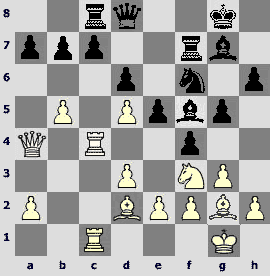
19.Јxa7! With a clear understanding of the fact that queen's menu contains toadstools growing on the edge of a forest.
19...¦a8 20.Јxb7 c5 21.dxc6. After 21.Јc6 ¦c7 the queen can be caught anyway, so burn it!
21...¦xb7 22.cxb7 ¦b8 23.¦c7. Queen sacrifice suggested itself. If the pawn now reaches а6, then another sacrifice is possible.
23...¤e8. For 23...¤d5 there is 24.b6 ¤xb6 25.Ґa5 – only this detail should have been calculated.
24.b6 d5. Some activity should be shown, because 24...Ґd7 doesn't prevent 25.a4: on pawn capturing 26.¦c8 wins.
25.Ґb4 (threatens Ґe7) 25...Јf6. To illustrate what I said in the annotation to the 23th move – 25...Ґd7 26.a4 e4 27.a5 exf3 28.Ґxf3, and Black cannot escape.
26.¦1c6! (an amusing neighborhood of rooks and pawns!) 26...¤xc7 27.¦xf6 Ґxf6 28.bxc7 ¦xb7. Exchange was Black's last hope, but there is a new blow waiting for him.
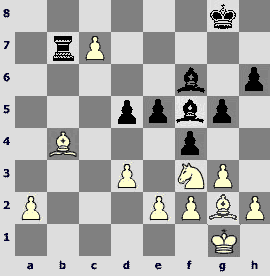
29.¤d4! I suppose that a combination of queen sacrifice and this finishing trick secured Arkadij Rotstein the place in the top ten in a majority of the lists. It really looks splendid: 3 major white war units are attacked. There was also an alternative 29.¤h4! with additional variation 29...Ґe6 30.Ґxd5!
29...e4. White gets overwhelming material advantage also in other simple lines: 29...exd4 30.Ґxd5+ or 29...¦xb4 30.Ґxd5+ ўh7 31.¤xf5 ¦b1+ 32.ўg2 ¦c1 33.Ґc4.
30.¤xf5 ¦xc7 31.dxe4 ¦c1+ 32.Ґf1 dxe4 33.gxf4 gxf4 34.Ґd2 ¦c5 35.¤xh6+ ўg7 36.¤g4 Ґg5 37.h4 ¦c2 38.hxg5 ¦xd2 39.¤f6 e3 40.¤h5+. Black resigned.
In the second part of the review all our attention will be paid to the creative work of the young, and now after we have applauded the achievement of 44-year-old Rotstein, let's see how much powder is still left in the powder-horns of a more aged person.
J.Timman–Y.Kuzubov
Goteborg 2005
1.c4 e5 2.g3 ¤f6 3.Ґg2 ¤c6 4.¤c3 Ґb4 5.¤d5 Ґc5 6.e3 ¤xd5. We point out the resemblance to the previous game: again the English opening, again Black attacks d5 early. He doesn't need to hurry – 6...0-0 7.¤e2 a6 or 7...¦e8.
7.cxd5 ¤e7 8.¤e2 0-0 9.0-0 c6. It is not a secret that the result of the game and sometimes even course of the struggle greatly affect a commentator's assessment. Nevertheless suggesting 9...d6 with possible continuation 10.d4 Ґb6 (10...exd4 11.¤xd4 ¤f5) 11.dxe5 dxe5 12.¤c3 does not look unnatural in this situation.
10.d4. Gavrikov once played 10.Јc2, but that game is not illustrative because of the difference in the class of the opponents.
10...exd4 11.exd4 Ґb6. One can sense the play of fortune in this move. A small one-game fortune. After all that happened Yuriy Kuzubov would have to agree that Black acted more successfully in Rasmussen-Bergstrom (Denmark-Sweden match, 1988) – 11...Ґd6 12.¤c3 cxd5 13.¤xd5 ¤xd5 14.Ґxd5 Јf6 15.¦e1 ¦b8. Although there are still questions to the opening setup. If White didn't hurry to capture the weak d5-pawn, but probed the opponent instead by p.e. 13.Ґg5, then Black would still have to solve some development problems.
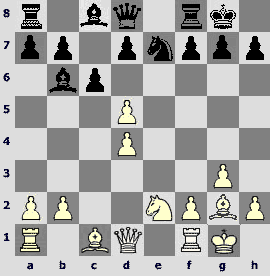
12.d6! Of course, Timman understood that he sends the pawn to death. But he couldn't tell for sure what should be the fortune of the light-squared black bishop.
12...¤f5 13.Ґf4 Јf6 14.Ґe5 Јh6 15.¤c3 ¤xd6 16.d5 ¤f5. If the knight tries to go off the attack with tempo – 16...¤c4, then after 17.Ґf4 Јg6 (with 17...Јf6 queen gets under ¤e4) 18.Јe2 he will have to learn the technique of going back.
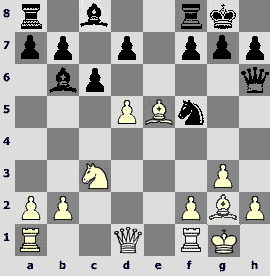
17.d6! The burden of the defeat nightmare: all the night you capture white d6-pawn, and every time a new one arises at the same spot. I wrote a lot about Hydra recently so I will not go deep in a subject.
17...¦e8. How lucky this veteran is! Someone else could have failed to find 18.Ґxg7! Јxg7 19.fxe3 after 17...¤e3, and Black not only fails to win a second pawn, but also gets a hole in the king defense.
18.¦e1 ¦e6. Pushing with all the forces on the nagging pawn, one shouldn't forget about the rear. In case of18...Ґc5 19.Ґf4 ¦xe1+ 20.Јxe1 g5 (or 20...Јe6 21.Јd2 with subsequent ¦e1) 21.Ґxg5! Јxg5 22.¤e4 Јg6 23.¤xc5 Јxd6 24.Јc3 и 25.¦e1 White has a strong initiative.
19.Јd3. Here 19.Ґf4 Јf6 brings nothing, and Black can make19...f6! after 19.Јf3.
19...Јh5. With white queen on d3 19...f6 20.Ґf4 doesn't suit, and after that White takes е6 and pushes d6-d7. Again not satisfactory is 19...¤e3, now because of 20.Ґf4 ¤xg2 21.Ґxh6 ¤xe1 22.Јf5 g6 (22...gxh6 23.ўf1) 23.Јf4 ¤d3 24.Јh4, and dark squares do not lend credibility.
20.Ґf3 Јg6. Thecontinuations where black queen doesn't provoke pin are be more reliable – 20...Јh3 or 20...Јg5.

21.Ґf4. In my point of view21.Ґe4 is a good move, for example, 21...¦xe5 (after 21...Ґxf2+ 22.ўxf2 ¦xe5 23.ўg2 and ¦f1 Black would have to give something up) 22.Ґxf5 Јf6 23.ўf1!? (much more fascinating than 23.¦xe5 Јxe5 24.Ґxh7+ ўf8 25.Ґe4 Јd4; however, 23.Јd2! with the same aim of seizing the e-file is evidently better) 23...¦xe1+ (23...g6 24.¦xe5 Јxe5 25.Ґh3) 24.¦xe1 g6 (behind bishop's back there is mate, but it doesn't disturb White) 25.¦e8+ ўg7 26.¤e4 Јxb2 (26...Јxf5 27.Јc3+ ўh6 28.Јh8!, and it's hard time for black king) 27.ўg2. Now the serial capture of minor pieces leads to the mate by major ones – 27...gxf5 28.Јf3 fxe4 29.Јg4+, and if minor are left on board, king will be soon attacked by everyone.
21...¤d4 22.Ґe4 Јh5 23.Ґg2 Јg6 24.Ґe4 Јh5 25.¤a4 f5. 25...Ґa5 26.Јxd4 Ґxe1 27.¦xe1 f5, suggested by computer, does not suit. Firstly because of general considerations: Black loses one more active piece and at the same time white a1-rook successfully replaces its workmate. Secondly, in almost all forced variations 28.¤c5 ¦e8 (28...¦xe4 29.¤xe4 fxe4 30.¦xe4 и ¦e7) 29.Ґd5+! cxd5 30.¦e7! ¦xe7 31.dxe7 d6 (31...Јf7 32.Јxd5!; 31...Јe8 32.Јxd5+ ўh8 33.Ґd6; 31...ўf7 32.Ґd6) 32.Јxd5+ ўh8 33.Јxd6 Јe8 34.Јd8 Ґd7 35.¤xb7 the arising positions could be managed without general considerations.
26.¤xb6 fxe4 27.Јxd4 axb6 28.¦xe4 Јc5 29.Јd3 Јf5 30.¦ae1 ¦a4. Probably, one needed to provide oneself with a pawn – 30...¦xa2. There is no direct refutation to it, e.g. 31.Јb1 ¦xb2! (in the ending after 31...¦a5 32.¦xe6 dxe6 33.Јxf5 ¦xf5 34.Ґe5 problems with space can arise) 32.Јxb2 ¦xe4 33.¦xe4 Јxe4, and Black is out of danger. 31.b4! is better, and Black still plays without a bishop. From a practical point of view Kuzubov was right in his decision, but in the end of the game he didn't show iron will in the opening development.
31.f3 h5 32.Јb3 ¦axe4 33.fxe4 Јc5+ 34.ўg2 g5. It was time to pay attention to the prisoner – 34...b5 with subsequent b7-b6.
35.Ґe3 Јxd6 36.Ґxg5 Јc5?! And again36...b5 deserved some attention. The bishop cannot move to f6 because of the check on d2, and in case of 37.e5 Јd5+ 38.Јxd5 cxd5 a very funny position appears: Black finally manages to move the bishop somewhere to c6 and survive in the endgame with opposite-colored bishops.

37.Ґf6! d5 38.e5 Јd4? I told you about the fortune. Bishop had no luck to make a move in this game. After the only 38...Ґd7 39.Јd3 Ґe8 40.Јf5 Ґf7 Black still holds, although his position is undoubtly unpleasant. Now everything ends in a moment.
39.Јc2. Black resigned, because there is nobody left to protect the king.
Now it's time for the highest-rated game of our set. Psychological background is Kramnik's desire for the victory as Black in the last round.
E.Bacrot–V.Kramnik
Dortmund 2005
1.d4 ¤f6 2.c4 e6 3.¤c3 Ґb4 4.¤f3 c5 5.g3 cxd4 6.¤xd4 ¤e4 7.Јd3 Ґxc3+. 7...Јa5 is cast aside. Evidently, according to Vladimir, the danger of being "dried out" is much higher there.
8.bxc3 ¤c5 9.Јf3. Earlier the move was 9.Јe3, but then it was found out that endgame without a pawn after 9...b6 10.Ґg2 Ґb7 11.Ґxb7 ¤xb7 12.Јe4 ¤c6 13.¤xc6 dxc6 14.Јxc6+ Јd7, is highly favorable for Black.
9...d6. Another good continuation is 9...¤c6 10.Ґf4 0-0. But let's look on it from Kramnik's point of view. In one of the earliest games on this topic Bacrot-Akopian (Enghiene-les-Baines 2001) occurred 11.¦d1 Јa5 12.Ґd6 ¤xd4 13.¦xd4 b6 14.Јxa8 Јxc3+ 15.¦d2 Јa1+ with a draw and perpetual check. Then in search of advantage White tried 11.Ґg2 b6 12.¤xc6 dxc6 13.¦d1 Јf6 14.Ґd6 Јxf3 15.Ґxf3 ¦d8 16.Ґxc5 ¦xd1+ 17.ўxd1 bxc5, and here there was a draw after both 18.Ґxc6 ¦b8 19.ўc2 ўf8 20.¦d1 ўe7 21.f4 ¦b6 22.Ґb5 ¦d6 etc. (Moiseenko-Arencibia, Kapuskasing 2004), and 18.ўc2 Ґa6 19.Ґxc6 ¦d8 20.Ґb5 Ґb7 21.f3 ўf8 etc. (Bacrot-Kulaots, Bled 2002). The course of struggle in both examples is far from desired complexity and sharpness.
10.Ґg2.
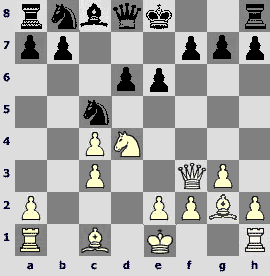
10...Ґd7. Moving away from the main theoretical variation – 10...¤bd7 11.0-0 ¤e5 12.Јf4. Here, as it was shown in Kumaran-Ruban, Hastings,1991, the pawn capture 12...¤xc4 is doubtful because of 13.¤b3! ¤b6 14.¤xc5 dxc5 15.Јe5 0-0 16.Јxc5 ¦e8 17.Ґa3. Black gets a strong position after 12...Ґd7. There are several examples:
13.¤b5 Ґxb5 14.cxb5 0-0 15.¦d1 ¦c8 16.Јb4 d5 17.Ґf4 Јf6 18.Ґe3 b6 19.Ґd4 Јf5 20.f3 h5 21.Јb1 Јxb1 22.¦axb1 ¤c4, Milov-Aronian, Warsaw 2005;
13.¤b3 ¦c8 (Gyimesi against P.Horvath Hungary, 2002, dared to castle long – 13...Јc7 14.Ґa3 f6 15.¦fd1 0-0-0 16.Јd4 Ґa4 17.¦ab1 b6) 14.Јd4 (14.Ґa3 leads to more or less the same: 14...b6 15.Јd4 f6, Moiseenko-Akopian, Tripoli 2004) 14...f6 15.Јxd6 b6 16.Јd4 ¤a4 17.¤d2 Ґc6 18.Ґh3 Јe7 19.f4 ¤f7 20.Јe3. In this position Kramnik as White agreed to a draw with Serper (Gdynia 1991).
Again it seems that Vladimir had rich negative information, I mean he clearly realized in which positions he cannot expect a struggle. He knew worse where turoid water runs.
11.0-0 Ґc6. A couple weeks earlier there was a game Nilssen-K.Berg, Aarhus 2005, in which there was 11...0-0 12.¦b1 Ґc6 13.¤xc6 ¤xc6 14.Ґf4 Јe7 15.¦fd1 ¦fd8 16.Јh5 ¦ac8. In about ten moves it ended in a draw. It's not improbable that Berg's move order is more suitable for the purpose.
12.Јg4 0-0. A desperate 12...Ґxg2 13.Јxg7 Ґxf1 14.Јxh8+ ўd7 15.Јxh7 Јf6 16.ўxf1 needs stronger reasons than those of Kramnik that day. No sharpness appears and two pawns are lost.
13.Ґh6 Јf6 14.Ґg5 Јg6 (14...Јe5 15.Ґf4 is bad) 15.¤xc6 ¤xc6 16.Јh4. During several last moves White had no choice and now they can act more or less freely. Vladimir made an unsuccessful decision. Possibly being afraid of exchange on c6 with subsequent Ґe7, he weakens the 7th rank. He had to begin the play against doubled pawns by 16...¤a4.
16...f6 17.Ґe3 ¦fd8. Here White can meet 17...¤a4 by 18.¦ab1. Naive 18...¦ab8? is met by 19.¦xb7! ¦xb7 20.Ґxc6, and in case of 18...¤xc3 19.¦xb7 ¤xe2+?! 20.ўh1 white pieces raise their activity and black pieces hang. Without including 16...f6 17.Ґe3 Black would have moved a knight from с6 to d4, and ther is something special in the position.
18.¦ab1. It was possible to exchange minor pieces right here 18.Ґxc5 dxc5 19.Ґe4 f5 20.Ґxc6 bxc6 and go for a pawn – 21.Јe7. Black would have answered 21...f4 with sufficient counterplay for a pawn in case of 22.Јxc5 Јe4 or with material and positional equality in case of 22.¦ad1 ¦xd1 23.¦xd1 ¦f8. But it would be wrong to think that Etienne Bacrot, one of the best chess players in the world, is obsessed by the idea of not letting Kramnik win as Black. So far he attacks the b7-pawn.
18...Јf7?! Queen goes to less active position, Bacrot notices and uses that marvelously.18...¦ab8 would have been better.
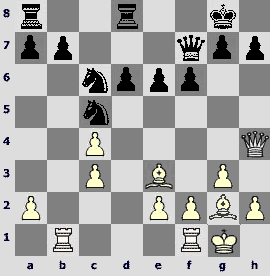
19.Ґxc6! (now it's time!) 19...bxc6 20.Ґxc5! dxc5 21.Јe4! Giving up all the bishops in one move. It's absurd, ridiculous, thoughtless, and instructive. In the symmetric position the difference in queens' activitydefines the advantage of White.
21...e5 22.¦b2 (it's obviously too early for the exchange of the c-pawns) 22...¦ab8 23.¦fb1 ¦xb2 24.¦xb2. If we look closely, white king has a more comfortable position than his vis-à-vis and it allows easier manipulation with the rook.
24...Јd7 25.ўg2 (suppressing all the ideas with the queen move on h3) 25...¦e8. After 25...Јc7 26.Јe3 Јa5 black queen has a more active position than in the game, but nevertheless it is aside of the main action. After a hasty 27.¦b7 Јxa2 28.Јe4 ўh8 or 28.Јxc5 Јxe2 29.Јe7 Јe4+ 30.ўh3 (30.f3?? ¦d2+) 30...Јf5+ Black would hold the position, but a calm 27.h4! puts him in a tight corner. For example, one of the dangerous plans of White is to occupy the 7th rank with the rook with the subsequent g-pawn march.
26.Јe3 Јe7 27.a4 g6. Kramnik chooses a set-up that does not allow white rook on the 7th rank. Another positioning was with 27...e4 28.a5 Јe5 29.¦b7 ¦e7 30.a6 ўf7 31.Јd2. Queen ending after 31...¦xb7 32.axb7 Јc7 33.Јb2 Јb8 34.Јb1 looks very suspicious, but with 31...ўe8 it is possible to protect invasion squares.
28.a5 ¦d8? It seems to be a miscalculation. Correct is 28...¦c8 29.a6 ¦c7, and if 30.Јh6, then 30...¦d7. Now the c6-pawn is attacked.
29.a6 ¦d7 30.¦b8+ ўg7 31.¦c8 Јd6 32.Јe4.
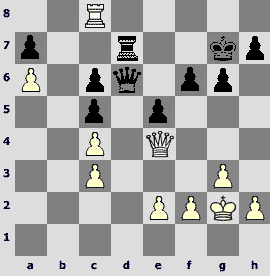
32...f5? It's one of the rare cases when rook ending gives no hope. 32...¦c7 would have been the right continuation 33.Јd3 Јe7 34.¦xc7 Јxc7 35.Јb1. After Јb7 White will gain the c6-pawn, but he still needs to work to create a second weakness, because doubled c-pawns cannot move anywhere by themselves.
33.Јxc6 Јxc6+. 33...ўf6 34.¦c7! ўe6 doesn't help. Touching neighborhood of opposing pieces is wrecked by 35.Јd5+! Јxd5+ 36.cxd5+ ¦xd5. After that White gets all the harvest on the 7th rank: 37.¦xh7! (37.¦xa7 would be also sufficient), and the pawn endgame after 37...¦d7 38.¦xd7 ўxd7 39.ўf3 and е4 is easily won.
34.¦xc6 ўf7 35.f4! There isno need to hurry with taking a pawn 35.¦xc5 and calculate whether the pawn ending is won after 35...ўe6 36.¦c6+ ¦d6 37.¦xd6+ ўxd6 (looks like it is not).
35...exf4. Maybe 35...¦d2 leaves slightly more practical chances, but the assessment is unambiguous.
36.gxf4 ¦e7 37.ўf3 ўe8 38.¦xc5 ўd7 39.¦e5 ¦xe5 (39...¦f7 40.¦b5 ўc6 41.e4 is also hopeless) 40.fxe5.
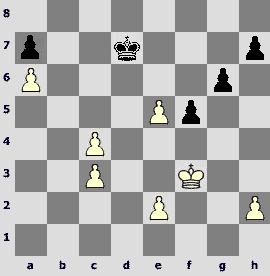
In this game Bacrot has already used the postulate that the advantage of two bishops is a chance of exchanging one of them for a knight. He used it in the way insulting for the opponent and for the bishops as well. But he doesn't want to stop. Now he proves that the advantage of two extra doubled pawns is a chance to get rid of one of them in a suitable moment.
40...g5 41.c5 h6 42.c4 h5 (42...ўd8 43.c6 ўc7 44.c5 ўxc6 45.e6 ўc7 46.ўe3) 43.h4! A more colorful situation arises after 43.e4 f4 44.h4 g4+ 45.ўxf4. The main point is the same: White cannot win without king's help but as soon as he forgets about the opponent's protected passed pawn, everything becomes clear.
43...g4+ 44.ўf4 ўe6 (44...ўd8 leads to the same position: 45.c6 ўc7 46.e6 ўxc6 47.c5 ўc7 48.e3) 45.c6 ўe7 46.c5 ўe6 47.c7 ўd7 48.e6+ ўxc7 49.e3! ўc6 50.ўe5! g3 51.e7 ўd7 52.ўf6 g2 (52...ўe8 53.c6 g2 54.c7) 53.c6+ ўc7 54.e8Ј g1Ј 55.Јd7+ ўb6 56.c7. Black resigns.
Next game was not in the top ten, according to the results of voting, but there are many reasons to annotate it: minimal gap between it and Bacrot-Kramnik that was on the 10th place, insistent recommendation of Sergei Ivanov to pay attention to the queer rook transfer and finally the name of the winner. In the high level tournaments Magnus Carlsen doesn't have a chance to show himself, but he displays all the brilliant facets of his talent against opponents of lower class. In the championship of Norway he played three games that are worth being published. We'll discuss the most successful one.
M.Carlsen–G.Tallaksen
Championship of Norway 2005
1.¤f3 ¤f6 2.c4 e6 3.d4 b6 4.g3 Ґa6 5.b3 b5 6.cxb5 Ґxb5 7.Ґg2 d5 8.0-0 ¤bd7 9.¤c3 Ґa6 10.¦e1 Ґd6. Karpov chose 10...Ґb4 against Anand (Monte Carlo 1997) and soon got equal ending after 11.Ґd2 c5 12.dxc5 Ґxc5 13.b4 Ґxb4 14.Јa4 Јa5 15.Јxa5 Ґxa5 16.¤xd5 Ґxd2 17.¤xf6+ ¤xf6 18.¤xd2 ¦c8. The way to improve is evident – 12.a3, obtaining the two bishops. Belyavsky secured an escape route for the bishop in the game with Abramovic (Nova Gorica, 2000) – 11...0-0 12.a3 Ґe7 (being satisfied with the modest location of the opponent's bishop) 13.b4 Ґb7 14.Јc2 a5 15.¤a4, and Black had to work to equalize.
11.Ґb2. Many pieces left the board on the early stage in Bologan-Vallejo (Sansenso 2004): 11.Ґg5 0-0 12.a3 Ґb7 13.e4 dxe4 14.¤xe4 h6 15.Ґxf6 ¤xf6 16.¤fd2 ¤xe4 17.Ґxe4 Ґxe4 18.¦xe4. Viorel then managed to create some problems, but this position is not quite suitable for a full-fledged game.
11...0-0 12.e4. I.Novikov hesitated a bit with this thematic move against Stocek (Philadelphia 2004), and after 12.¦c1 ¦c8 13.¦c2 Јe7 14.e4 ¤xe4 15.¤xe4 dxe4 16.¦xe4 ¤f6 17.¦e1 Ґb4 18.Ґc3 c5 situation was equal. As we see, the reference games were rather dull. But the text game generously repays it.
12...¤xe4 13.¤xe4 dxe4 14.¦xe4 Ґb7.
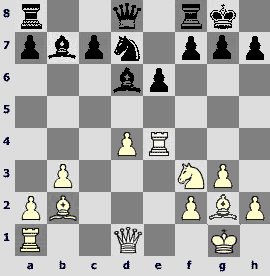
15.¦h4!? Ґe7 16.¦h3. And why not? What a joy is in standing on e1, looking thoughtlessly on the e6-pawn and other available empty squares along the file? And in a corner the rook has an obvious target.
16...¤f6. Checking documents of the strange rook seems to give no reason for a trial, e.g. 16...Ґe4 17.¦c1 Ґf5 18.¦h5, and now in case of 18...Ґg6 it goes to the other side of the board – 19.¦a5, and in case of 18...¤f6 White gets a promising position, sacrificing an exchange 19.¦xf5 exf5 20.¤h4. The capture on follows on 18...g6 as well.
17.Јe2 Ґd5 18.¦e1 Јb8?! Too phlegmatic! One should have spiced up the game by 18...a5.
19.¤e5 Јb7 20.Ґxd5 Јxd5. There is a constant feeling that black queen could have arrived here in one move.
21.Јc2 c5? Comparative analysis of the values of c7- and h7-pawns is done with a blunder. One should have seen that fortunately in case of21...h6 22.¤c6 Ґd6 23.¦e5! the queen has one spare square, and continue the game by 23...Јf3 24.¦e3 Јd5 25.¦h4. And such inconvenience as 22.Јxc7 Ґd6 was not a big deal. Now Black will have to defend against constantly arising threats throughout the game.
22.¤g4 h6 23.¦e5 Јf3.
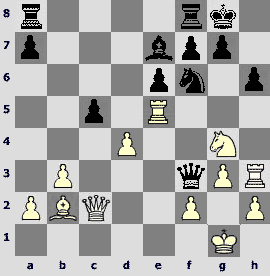
24.¤xh6+! Somewhere far, far away a baby smiled, slightly rocking in the cradle.
24...gxh6 25.¦xh6 ўg7 (25...¦fd8 is followed by firm 26.¦g5+ ўf8 27.¦h8+) 26.¦g5+! ўxh6 27.Ґc1!

White lacks a rook and a knight, but black queen is inevitably lost, and this is only a beginning...
27...cxd4 28.¦g4+. After 28.¦g8+ ўh5 White have nothing better than 29.¦g5+ ўh6.
28...Јe3 (28...ўh5 29.¦h4#) 29.¦h4+. Certainly not 29.fxe3 ¤xg4 nor 29.¦xd4 Јxc1+ 30.Јxc1+ ўg6.
29...¤h5. Our gratitude to Black for his refusal of 29...ўg7 30.fxe3, which would be equal to resignation.
30.¦xh5+! ўxh5 31.Јh7+ ўg4 32.fxe3 ¦ac8.
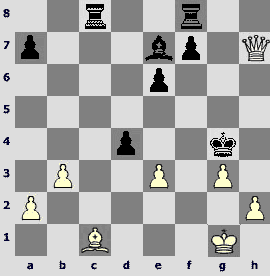
33.ўg2! Marvelous finish. White does not need a bishop to mate crown-bearing darer.
33...¦xc1 34.h3+ ўg5 35.Јg7+ ўf5 (35...ўh5 36.g4+ ўh4 37.Јh6#) 36.g4+ ўe4 37.Јxd4#.
The review ends with the 2nd-placed game, in which Alexei Shirov was defeated in the way characteristic of his own best games. The novelty of Mark Bluvshtein will certainly be one of the contenders for the Chess Informant's Oscar.
A.Shirov–M.Bluvshtein
Edmonton 2005
Let me omit the opening comments and move right to crucial point.
1.e4 e5 2.¤f3 ¤f6 3.¤xe5 d6 4.¤f3 ¤xe4 5.d4 d5 6.Ґd3 Ґd6 7.0-0 0-0 8.c4 c6 9.Јc2 ¤a6 10.a3 Ґg4 11.¤e5 Ґf5 12.b4 f6 13.¤f3 Јe8. Last year in the round-robin tournament in Montreal Mark played this position twice as Black. Both Lahno and Nataf chose14.c5 Ґb8 15.¤c3 Ґg6 16.¤h4 f5 17.¤xg6 Јxg6 with a complicated game. The text move had also happened in practice.
14.b5. Lahno-Polovnikova game from women's world championship in Elista 2004 continued 14...cxb5 15.c5! Ґc7 16.¤c3 ¦d8 17.¦e1 Јh5? (17...Ґa5) 18.¤xe4 Ґxe4 19.Ґxe4 dxe4 20.¦xe4 with evident advantage of White.

14...Јh5! Here it is, the most powerful improvement. What, knight stands bad on the rim? So let's burn it in the same fire as Rotstein's queen!
15.bxa6 Ґg4 16.¦e1. The sacrifice had to be accepted, but here the possibilities are different. Let's first state that Black is going to take on f3 and reject primitive defense.
In case of 16.Ґxe4 Black has to remember that attack is weaker than a threat and choose 16...dxe4 instead of 16...Ґxf3 17.Ґxh7+ ўh8 18.h3, and after 17.Јxe4 again reject 17...Ґxf3 18.Јe6+ ўh8 19.Јxd6 and favor 17...¦ae8! Now he wins a piece back when all his forces are ready, while half of the opposing army is still on the initial squares.
16.h3 Ґxf3 17.gxf3 Јxh3 18.f4 f5! doesn't suit too, and the rook appearance on the g-file can be slightly postponed with the help of 19.Ґxe4 fxe4 20.Јc3 Јf5 (or 20...Јh5) 21.axb7 ¦ab8.
Unobvious 16.¤h4! Јxh4 17.f4 is of much greater interest. White king gets a break, and Black cannot thoughtlessly celebrate the restoration of material equality because his pawn chain is in danger. Straightforward 17...bxa6?! 18.cxd5 cxd5? 19.Јc6 looks also bad, so he has to develop the initiative against his own will.
It's hard to assess the situation after 17...f5! 18.axb7 ¦ad8. Possibly there will be the supporters of both sides. Here are rough sample lines: 19.cxd5 cxd5 20.¤c3 (20.Јc6!? Ґb8, and maybe Black will manage to win a tempo by sending the rook on h6) 20...¦f6!? 21.¤xd5 (in case of 21.g3!? ¤xg3! an orgy of pins begins and Black leaves it in better condition – 22.Јf2 ¦g6 23.hxg3 Ґf3! 24.Јg2! Ґxg2 25.gxh4 Ґe4+ 26.ўh2 Ґxd3, and to be sure one has to take the b7-pawn afterwards and continue to attack in the endgame) 21...¦h6 22.h3 (here 22.g3 looks less attractive because of 22...¤xg3 23.Јf2 ¤xf1 24.Јxh4 ¦xh4 25.Ґxf1 Ґf3, and Black attacks with extra exchange) 22...Ґxh3 23.¤e3 Ґxg2! 24.Јxg2 ¦g6 or 23.Ґxe4 fxe4 24.Јxe4 Ґxg2 25.Јxg2 ¦g6. Black gets a queen for a rook and a minor piece in a sharp position. Exercise is over, let's move to the starting position.
16...Ґxf3 17.gxf3 Јxh2+ 18.ўf1.

18...f5! A marvelous move that makes us remember Kramnik-Shirov game, Linares 1994! Alexei had the impudent e4-rook there.
19.cxd5. In case of 19.axb7 ¦ae8 (the threat is 20...¤d2+ and 21...Јh1#) 20.fxe4 Јh3+ 21.ўe2 fxe4 22.Ґe3 another destructive blow follows –
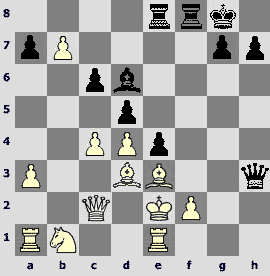
22...¦xf2+! 23.ўd1 (23.Ґxf2 exd3+) 23...¦xc2 24.Ґxc2 Јf3+ 25.¦e2 Јf1+ 26.ўd2 (26.¦e1 Јxc4) 26...Ґf4, and White, despite having sufficient material equivalent for a queen, does not have time to cooperate his pieces.
19...cxd5 20.fxe4 (it could not be tolerated for a long time anyway) 20...fxe4 21.Ґxe4. Exactly, the f2- square has to be looked for permanently. Loss of attention leads to disaster. For example: 21.Ґe3 exd3 22.Јxd3 Ґg3 23.¦a2 ¦ae8!, and again adding the a8-rook has a destructive effect, because now king cannot cross the e-file. After 24.axb7 Јh3+ 25.ўg1 the full stop comes with 25...¦f4! 26.b8ЈҐh2+ 27.ўh1 Јf3+ 28.ўxh2 ¦h4+ 29.ўg1 ¦h1#.
21...dxe4 22.Ґe3 Ґg3.
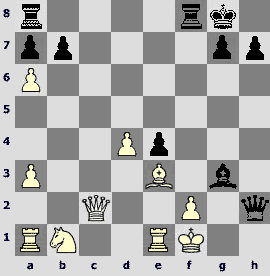
23.¦a2? All of a sudden this sensible move becomes a decisive mistake. One had to include 23.axb7! Black has perpetual check after 23...Ґxf2 24.Ґxf2 (24.bxa8Ј?? Јg1+ 25.ўe2 Јxe1#) 24...Јh1+ 25.ўe2 Јh5+, but is there any better chance? After 23...¦ab8 White plays 24.¦a2!, and there is no time for 24...¦xb7? because of 25.Јxe4. An attempt to bring about the same idea as in the game is not so good here, but the resources are sufficient for a draw: 23...¦ae8 24.¦a2 ¦f3 25.Јc4+ ўh8 26.Јb4! (defending the e1-pawn) 26...a5! (distracting the queen from f8) 27.Јxa5 Ґxf2 28.¦xf2 ¦ef8 29.Јd2 (the only move) 29...Јh1+ 30.ўe2 ¦xf2+ 31.Ґxf2 Јf3+ 32.ўf1 Јh1+, and finally perpetual check.

23...¦f3! A killing idea of ¦xe3+ appears! Variations like 24.Јb3+ ўh8 25.axb7 ¦af8 or 24.axb7 Јh1+ 25.ўe2 ¦xe3+! 26.ўxe3 (26.fxe3 Јxe1#) 26...Јxe1+ 27.Јe2 Ґxf2+ don't leave White a chance, so he resigns. This is the end of the July fairy-tale.
